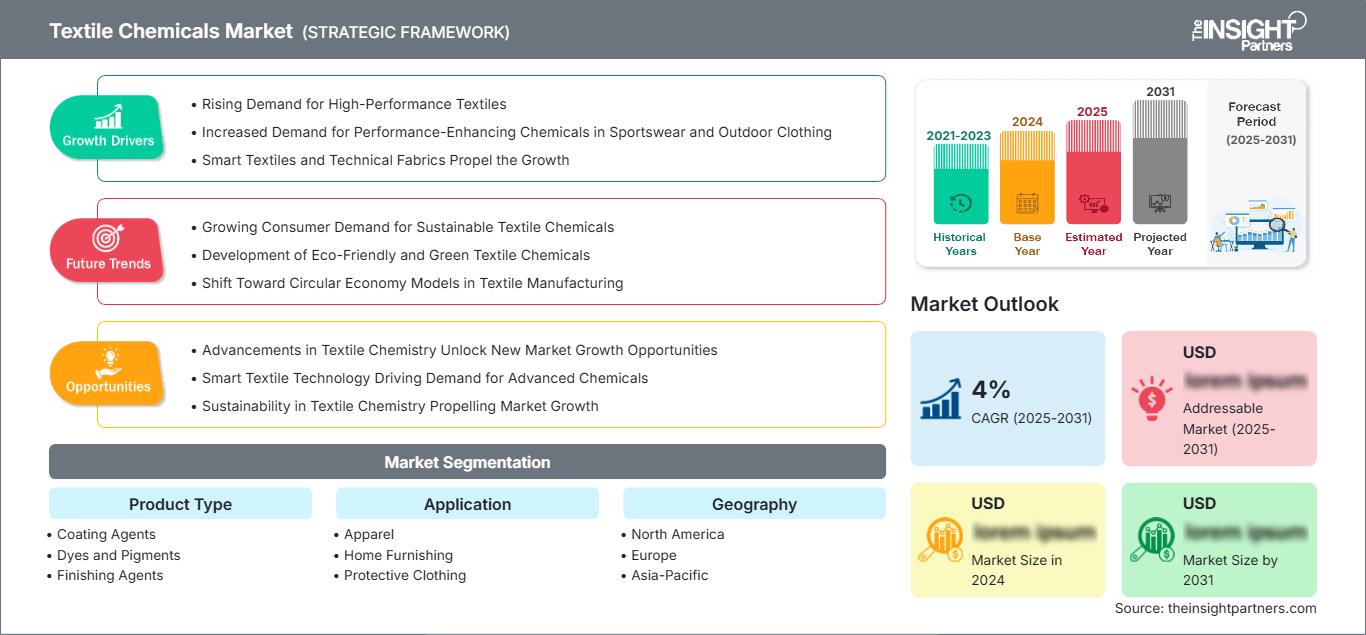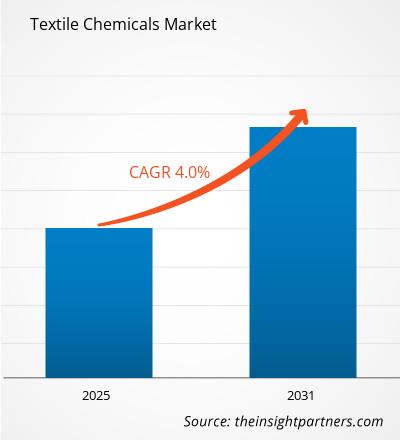Der Markt für Textilchemikalien wird bis 2031 voraussichtlich ein Volumen von 36,59 Milliarden US-Dollar erreichen. Für den Zeitraum 2025–2031 wird ein jährliches Wachstum von 4,6 % erwartet.
Der Bericht analysiert den Markt nach Produkttypen (Beschichtungsmittel, Farbstoffe und Pigmente, Ausrüstungsmittel, Tenside, Entschlichtungsmittel u. a.) und Anwendungsbereichen (Bekleidung, Heimtextilien, Schutzkleidung u. a.). Die globale Analyse wird zudem auf regionaler Ebene und für wichtige Länder aufgeschlüsselt. Marktgröße und Prognosen für alle wichtigen Marktsegmente auf globaler, regionaler und Länderebene sind enthalten. Die Werte für die Analysen und Segmente werden in US-Dollar angegeben. Der Bericht liefert wichtige Statistiken zum Marktstatus der wichtigsten Marktteilnehmer und zeigt Markttrends und -chancen auf. Ziel des Berichts ist es, die aktuelle Marktlage und das zukünftige Wachstum, die wichtigsten Treiber, Herausforderungen und Chancen zu beschreiben. Dies wird verschiedenen Akteuren im Geschäftsbereich Einblicke ermöglichen, wie beispielsweise:
- Technologieanbieter/Hersteller: Um die sich entwickelnde Marktdynamik zu verstehen und potenzielle Wachstumschancen zu erkennen, können sie fundierte strategische Entscheidungen treffen.
- Investoren: Um eine umfassende Trendanalyse hinsichtlich Marktwachstumsrate, Finanzprognosen und Chancen entlang der Wertschöpfungskette durchzuführen.
- Regulierungsbehörden: Um Richtlinien zu regulieren und Aktivitäten auf dem Markt zu überwachen, mit dem Ziel, Missbrauch zu minimieren, das Vertrauen der Anleger zu wahren und die Integrität und Stabilität des Marktes zu gewährleisten.
Marktsegmentierung für Textilchemikalien Produkttyp
- Beschichtungsmittel
- Farbstoffe und Pigmente
- Ausrüstungsmittel
- Tenside
- Entschlichtungsmittel
Anwendung
- Bekleidung
- Heimtextilien
- Schutzkleidung
Sie erhalten kostenlos Anpassungen an jedem Bericht, einschließlich Teilen dieses Berichts oder einer Analyse auf Länderebene, eines Excel-Datenpakets sowie tolle Angebote und Rabatte für Start-ups und Universitäten.
Markt für Textilchemikalien: Strategische Einblicke

- Holen Sie sich die wichtigsten Markttrends aus diesem Bericht.Dieses KOSTENLOSE Beispiel umfasst Datenanalysen, die von Markttrends bis hin zu Schätzungen und Prognosen reichen.
Wachstumstreiber des Marktes für Textilchemikalien
- Steigende Nachfrage nach Hochleistungstextilien: Die wachsende Nachfrage nach Hochleistungstextilien ist einer der Hauptfaktoren für das Wachstum des Marktes für Textilchemikalien. Verschiedene Branchen benötigen spezielle chemische Behandlungen von Hochleistungstextilien, um deren Haltbarkeit, Feuchtigkeitstransport, Flammschutz usw. zu verbessern. Daher besteht eine hohe Nachfrage nach fortschrittlichen Textilchemikalien.
- Zunehmende Nachfrage nach leistungssteigernden Chemikalien in Sport- und Outdoorbekleidung: Da die Textilindustrie nach funktionaleren Produkten strebt, steigt die Nachfrage nach Chemikalien mit verbesserter Leistung. Beispielsweise finden Chemikalien, die die Festigkeit, Elastizität und UV-Beständigkeit von Stoffen verbessern, wichtige Anwendungen in Sport- und Outdoorbekleidung. Dies ist einer der Gründe für das Wachstum des Marktes für Textilchemikalien, da Hersteller in innovative chemische Lösungen investieren.
- Intelligente Textilien und technische Gewebe treiben das Wachstum voran: Intelligente Textilien und technische Gewebe mit Sensoren oder leitfähigen Materialien stellen einen aufstrebenden Industriezweig dar. Solche Textilien benötigen Chemikalien für die komplexen Herstellungsprozesse, die sie durchlaufen, ohne die Funktionalität der eingebetteten Elektronik zu beeinträchtigen. Angesichts der wachsenden Anwendungsbasis intelligenter Textilien befindet sich der Markt für Textilchemikalien aufgrund spezieller Produkte auf einem rasanten Wachstumskurs.
Zukunftstrends im Markt für Textilchemikalien
- Steigende Verbrauchernachfrage nach nachhaltigen Textilchemikalien: Die steigende Verbraucherpräferenz für nachhaltige Produkte ist einer der wichtigsten Zukunftstrends, der das Wachstum des Marktes für Textilchemikalien antreibt. Verbraucher, die zunehmend umweltbewusster sind, fordern umweltfreundlichere Textilien. Dieser Trend hat Hersteller dazu veranlasst, nachhaltige Textilchemikalien einzusetzen, die die Umweltbelastung minimieren und gleichzeitig hohe Produktqualität gewährleisten.
- Entwicklung umweltfreundlicher Textilchemikalien: Die Entwicklung umweltfreundlicher Chemikalien wie biologisch abbaubarer Farbstoffe, wasserbasierter Ausrüstungen und umweltschonender Behandlungen von Textilien hat signifikante positive Auswirkungen auf Emissionen, Wasserverbrauch und die Menge an giftigen Abfällen, die bei der Herstellung entstehen, und erfüllt somit sowohl die Erwartungen der Aufsichtsbehörden als auch die der Verbraucher. Dies gibt dem Marktwachstum neuen Schwung, da Hersteller auf umweltfreundlichere Alternativen umsteigen.
- Umstellung auf Kreislaufwirtschaftsmodelle in der Textilherstellung: Die Mode- und Textilindustrie steht zunehmend unter Druck, nach Kreislaufwirtschaftsmodellen zu arbeiten, bei denen Produkte recycelt statt weggeworfen werden. Chemische Textilien, die den Recyclingprozess der Stoffe nicht beeinträchtigen, werden daher besonders berücksichtigt. Der Markt für Textilchemikalien entwickelt sich bereits weiter und bietet Lösungen, die Nachhaltigkeit in den Mittelpunkt stellen.
Marktchancen für Textilchemikalien
- Fortschritte in der Textilchemie eröffnen neue Wachstumschancen: Der Markt für Textilchemikalien bietet angesichts der Fortschritte in der Textilchemie enorme Wachstumschancen. Neue Formulierungen und Verfahren ermöglichen beispielsweise die Herstellung leistungsfähigerer und effektiverer Produkte. Darüber hinaus besteht Bedarf an Spezialchemikalien, um der stetig steigenden Nachfrage nach Langlebigkeit, Feuchtigkeitsmanagement und UV-Schutz in Textilien gerecht zu werden. Intelligente Textiltechnologie treibt die Nachfrage nach fortschrittlichen Chemikalien an: Die Integration intelligenter Technologien in Textilien fördert die Nachfrage nach fortschrittlichen Chemikalien für intelligente Textilien. Intelligente Textilien, die leitfähige Materialien oder Sensoren integrieren, benötigen Chemikalien, um ihre Funktionsfähigkeit zu gewährleisten. Da die Anwendung in den Bereichen Gesundheitswesen, Elektronik und Sportbekleidung zunimmt, könnte das Wachstum des Marktes für Textilchemikalien weiter ansteigen. Nachhaltigkeit in der Textilchemie treibt das Marktwachstum an: Fortschritte in der nachhaltigen Textilchemie spielen ebenfalls eine wichtige Rolle für das Marktwachstum. Umweltfreundliche und biologisch abbaubare Chemikalien, wie beispielsweise wasserbasierte Farbstoffe und ungiftige Ausrüstungen, werden entwickelt, um den Wandel der Branche hin zu umweltfreundlicheren Produktionsprozessen zu unterstützen. Umweltfreundliche Textilchemikalien gewinnen daher zunehmend an Bedeutung. Verbraucher suchen vermehrt nach umweltfreundlichen Produkten, während die Umweltgesetzgebung immer strenger wird.
Markt für Textilchemikalien
Die regionalen Trends und Einflussfaktoren auf den Markt für Textilchemikalien im gesamten Prognosezeitraum wurden von den Analysten von The Insight Partners ausführlich erläutert. Dieser Abschnitt behandelt außerdem die Marktsegmente und die geografische Verteilung des Marktes für die Behandlung von Herzrhythmusstörungen in Nordamerika, Europa, dem asiatisch-pazifischen Raum, dem Nahen Osten und Afrika sowie Süd- und Mittelamerika.
Umfang des Marktberichts zu Textilchemikalien
Berichtsattribut Einzelheiten Marktgröße in 2024 US$ XX Billion Marktgröße nach 2031 US$ 36.59 Billion Globale CAGR (2025 - 2031) 4.6% Historische Daten 2021-2023 Prognosezeitraum 2025-2031 Abgedeckte Segmente By Produkttyp - Beschichtungsmittel
- Farbstoffe und Pigmente
- Appreturmittel
- Tenside
- Entschlichtungsmittel
- Bekleidung
- Heimtextilien
- Schutzkleidung
- Nordamerika
- Europa
- Asien-Pazifik
- Süd- und Mittelamerika
- Naher Osten und Afrika
Abgedeckte Regionen und Länder Nordamerika - USA
- Kanada
- Mexiko
- Großbritannien
- Deutschland
- Frankreich
- Russland
- Italien
- Restliches Europa
- China
- Indien
- Japan
- Australien
- Restlicher Asien-Pazifik
- Brasilien
- Argentinien
- Restliches Süd- und Mittelamerika
- Südafrika
- Saudi-Arabien
- Vereinigte Arabische Emirate
- Restlicher Naher Osten und Afrika
Marktführer und wichtige Unternehmensprofile - Akzo Nobel NV
- Archroma
- Bozzetto Group
- DowDuPont
- DyStar Singapore Pte Ltd
- Evonik Industries AG
- Huntsman International LLC
- Rudolf GmbH
- Tanatex Chemicals B.V.
Dichte der Akteure im Markt für Textilchemikalien: Auswirkungen auf die Geschäftsdynamik
Der Markt für Textilchemikalien wächst rasant, angetrieben durch die steigende Nachfrage der Endverbraucher. Gründe hierfür sind unter anderem sich wandelnde Verbraucherpräferenzen, technologische Fortschritte und ein wachsendes Bewusstsein für die Vorteile der Produkte. Mit steigender Nachfrage erweitern Unternehmen ihr Angebot, entwickeln innovative Lösungen, um den Verbraucherbedürfnissen gerecht zu werden, und nutzen neue Trends, was das Marktwachstum zusätzlich beflügelt.

- Holen Sie sich die Markt für Textilchemikalien Übersicht der wichtigsten Akteure
Wichtigste Verkaufsargumente
- Umfassende Abdeckung: Der Bericht bietet eine umfassende Analyse der Produkte, Dienstleistungen, Typen und Endnutzer des Marktes für Textilchemikalien und vermittelt so ein ganzheitliches Bild.
- Expertenanalyse: Der Bericht basiert auf dem fundierten Wissen von Branchenexperten und Analysten.
- Aktuelle Informationen: Der Bericht gewährleistet Geschäftsrelevanz durch die Berücksichtigung aktueller Informationen und Datentrends.
- Anpassungsmöglichkeiten: Dieser Bericht kann an spezifische Kundenanforderungen angepasst werden und sich optimal in die Geschäftsstrategien integrieren.
Der Forschungsbericht zum Markt für Textilchemikalien kann somit maßgeblich dazu beitragen, das Branchenszenario und die Wachstumsaussichten zu entschlüsseln und zu verstehen. Auch wenn einige berechtigte Bedenken bestehen, überwiegen die Vorteile dieses Berichts insgesamt die Nachteile.
- Historische Analyse (2 Jahre), Basisjahr, Prognose (7 Jahre) mit CAGR
- PEST- und SWOT-Analyse
- Marktgröße Wert/Volumen – Global, Regional, Land
- Branchen- und Wettbewerbslandschaft
- Excel-Datensatz
Aktuelle Berichte
Verwandte Berichte
Markt für Flugzeugreinigungschemikalien Markt für Spurenchemikaliendetektoren Markt für Chemikalien zur Gummiverarbeitung Markt für Chemikalien aus Kiefernholz Markt für Chemikalien zur Schlammbehandlung Markt für Spezialoleochemikalien Markt für Sojachemikalien Markt für Chemikalien zur Textilveredelung Markt für plasmaunterstützte chemische Gasphasenabscheidung (PECVD) Markt für Thiochemikalien Markt für Imprägnierchemikalien Markt für Spezialchemikalien Markt für Dachchemikalien Markt für Agrochemikalien Markt für die Verteilung von Chemikalien in der Luft- und Raumfahrt sowie der Verteidigung Markt für Textilchemikalien Markt für erneuerbare ChemikalienErfahrungsberichte
Grund zum Kauf
- Fundierte Entscheidungsfindung
- Marktdynamik verstehen
- Wettbewerbsanalyse
- Kundeneinblicke
- Marktprognosen
- Risikominimierung
- Strategische Planung
- Investitionsbegründung
- Identifizierung neuer Märkte
- Verbesserung von Marketingstrategien
- Steigerung der Betriebseffizienz
- Anpassung an regulatorische Trends




















 Kostenlose Probe anfordern für - Markt für Textilchemikalien
Kostenlose Probe anfordern für - Markt für Textilchemikalien